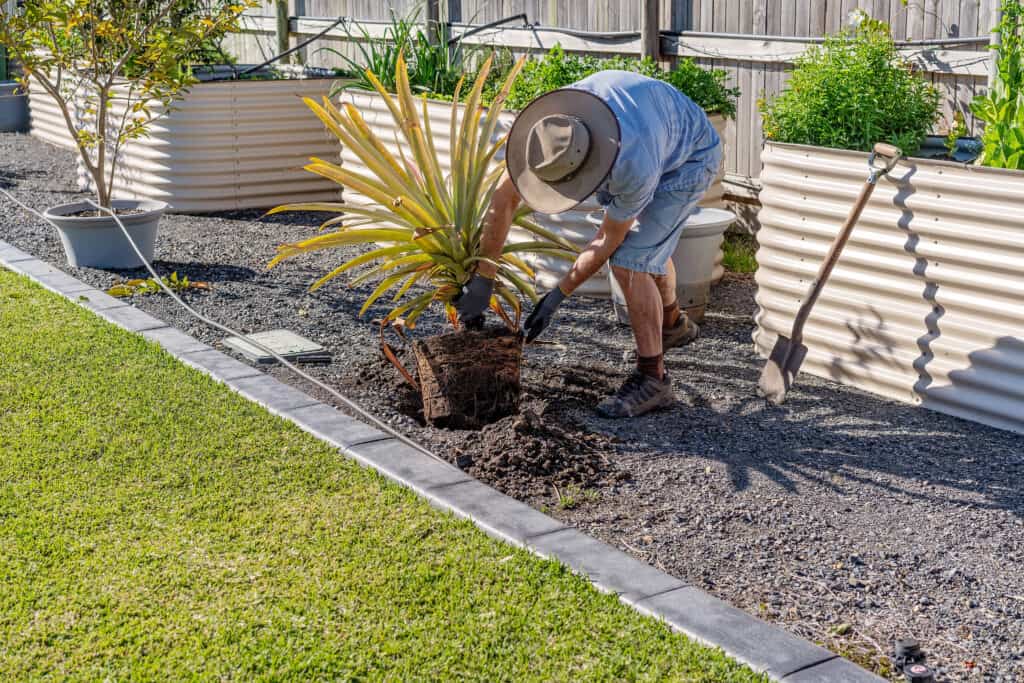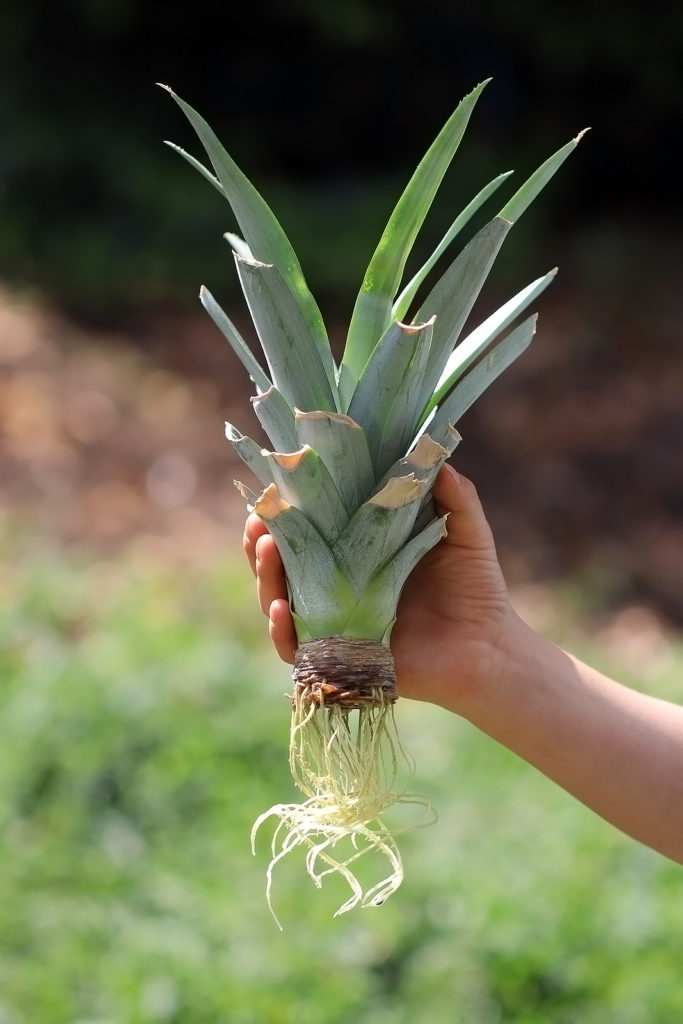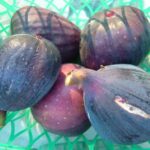The edible pineapple is a member of tropical plant genus Ananas. The species Ananas comosus produces the edible pineapple. The plant is known for its spiky leaves, compact growth habit, and the iconic, sweet-tasting fruit it bears. While widely grown for fruit production in tropical regions, Ananas can also be used as an ornamental plant in gardens or indoors.
Pineapple description
- Growth Habit: Pineapple plants grow in a rosette, forming a dense clump of leaves. They can reach a height of 3-5 feet, depending on the variety and growing conditions.Grow pineapples in tropical or near-tropical gardens. Pineapples can grow indoors if it is warm and there is plenty of light.
- Foliage: The pineapple plant has long, narrow, spiky leaves that grow in a rosette. The leaves are usually tough and can be edged with spines. Depending on the species or variety, the leaves can be plain green or striped with shades of red or yellow.
- Fruit: The most notable feature of the Ananas plant is its pineapple fruit, which grows at the center of the rosette on a tall stem. The fruit is a fusion of multiple berries and is covered in a rough, spiny skin. It’s commonly recognized for its sweet, tropical flavor.
The pineapple plant is short and stout. It grows 2 ½ to 5 feet tall and 3 to 4 feet wide at maturity. It has strap-like leaves that are serrated with needle tips. The oval to cylindrical-shaped pineapple fruit is actually many small fruits fused together. The pineapple is a compound fruit.
The waxy outer rind of the pineapple can be dark green, yellow, orange-yellow, or reddish when the fruit is ripe. The flesh ranges from nearly white to yellow. Fruit can weigh from 1 to 10 pounds or more.
Pineapple care tips
- Light: Pineapples prefer bright, indirect light. Outdoors, they should be placed in full sun for best growth and fruiting. Indoors, they should be positioned near a bright window.
- Watering: Pineapple plants should be watered when the soil feels dry to the touch. Water the soil directly, but be careful not to overwater, as they prefer well-draining conditions. Like other bromeliads, pineapples can also absorb water through their leaves, so misting occasionally can be beneficial.
- Temperature: Pineapple plants thrive in warm temperatures between 65-95°F (18-35°C). They are not frost-tolerant, so in cooler climates, they need to be brought indoors or protected during cold spells.
- Soil and Fertilization: Use well-draining, sandy soil for pineapple plants, similar to what you’d use for succulents or bromeliads. A balanced, water-soluble fertilizer can be applied sparingly during the growing season to promote healthy growth and fruiting.
Related article:
Best climate and site for growing pineapples
- Pineapples are tropical or near-tropical plants. Pineapples grow best where the temperature averages between 65° and 95° Pineapples can tolerate cool nights but growth will be slowed.
- Prolonged cold and freezing temperatures will delay maturity and make the fruit more acidic. Pineapples will be severely damaged at 28°
- Pineapples are grown outdoors in southern Florida, southern California, and Hawaii in the United States.
- Plant pineapples in full sun; pineapples do not ripen well in partial shade.
- Plant pineapples in compost-rich, sandy loam. The soil must be well-drained; pineapples will not grow in soggy soil.
- Pineapples prefer a soil pH of 4.5 to 6.5.

Planting pineapples
- Prepare a planting site in full sun that is sheltered from a prevailing breeze or wind. A south-facing wall that can collect and radiate solar heat is a good spot in cooler locations.
- Work well-rotted compost or manure into the soil.
- Mound the soil if it is not well-drained.
- Set a ground cover of black plastic over the planting bed; cut an X in the plastic to plant pineapples. Plastic ground cover will warm the soil, conserve soil moisture, and reflect heat up to the plant.
- Dig a hole half again as deep and twice as wide as the plant’s roots. Add a cupful of all-purpose fertilizer to the bottom of the hole.
- Set the plant in the hole so that the soil mark from the nursery pot on the stem is at the surface level as the surrounding soil. Spread the roots out in all directions.
- Re-fill the hole with half native soil and half aged compost or commercial organic planting mix; firm in the soil so that there are no air pockets among the roots. Water in the soil and create a modest soil basin around the base of the plant to hold water at watering time.
- After planting, water thoroughly and fertilize with a high-phosphorus liquid starter fertilizer.
- See Propagation below for more details.
Spacing pineapples
- Space pineapples according to their size at maturity.
- Pineapples can grow 2 ½ to 5 feet tall and 3 to 4 feet wide. Pineapple leaves are spiked so give the plant room.
Pineapple pollination
- Pineapple flowers are pollinated by hummingbirds.
- The stem of the pineapple elongates at flowering time. A small head of purple or red flowers forms at the tip of the stem. Individual fruits form from each flower; the flowers then join together to form a conical-shaped compound fruit that can be as large as 12 inches long and nearly as wide in circumference.
- The fruit’s interior is juicy and fleshy; its core is the elongated stem that bore the flowers to begin with.
Pineapple yield
- A pineapple plant commonly bears one head or fruit, occasionally two.

Container growing pineapples
- Pineapples are easy to grow in containers. Chose a container 24 inches wide and deep.
- Pineapples can be grown indoors in a warm, brightly lit spot.
Pineapple care, feeding, and watering
- Keep the soil evenly moist for best fruit production. Pineapples can withstand drought, but fruit yield will suffer.
- Feed pineapples every four months with a high-nitrogen fertilizer; a fertilizer formulated for citrus will work. Magnesium will help increase fruit weight.
- Pineapples can take nutrients in through their leaves; use a dilute fish emulsion or seaweed extract foliar spray.
- Mulch around plants with aged compost to conserve soil moisture and protect shallow roots.
- Pineapples are frost-sensitive; cover plants with a plant blanket or erect a frame around the plant and cover the frame with clear plastic sheeting if frost threatens.
Harvesting pineapples
- Pineapples are commonly harvested with a sharp knife; the fruit is cut away from the stalk and plant below.
- It takes 18 to 32 months for a pineapple to bear mature fruit.
- It is difficult to tell when a pineapple is ripe; size and color change are not reliable indicators of ripeness.
- The “eyes” or scales that run down the length of the pineapple will turn a light pale green color when the fruit is ripe.
- Ripe fruit will make a dull, solid sound when thumped by a finger. Immature fruit will make a hollow thud.
- Pineapples do not continue to ripen after harvest.
- Ripe fruit can be cut from the plant with a sharp knife; some fruit will break away from the plant with a twisting jerk.
Preparing pineapples
- To peel and section a pineapple, slice off the leafy frond at the top and stand the pineapple on its stem end. Slice the fruit in quarters lengthwise and cut away the central core. The flesh of each quarter is cut away from the rind with a large sharp knife. Cube or dice the flesh and serve.
- Fruit will keep for two or three weeks at 45°F.

Pineapple propagation
- Pineapples are propagated by vegetative growth. Here are the options: slips that arise from the stalk below the fruit can be cut away and replanted; suckers that originate from the axils of leaves can be separated and planted; crowns that grow from the top of fruits can be sliced away and planted (see below); ratoons or “pups” that grow from the underground portion of the stem can be separated and replanted.
- Suckers growing from leaf axils or pups that grow near the base of the plant can be separated and planted in moist soil. Suckers and pups will take about 18 months to bear fruit.
- Crowns for replanting can be twisted or cut from the top of the fruit. Remove any of the fruit’s flesh and then let the crown dry for two days. Remove the lower, outer leaves from the crown to reveal ½ to 1 inch of the stem. Set the crown in light soil and firm the soil around the edges. Keep the soil lightly moist until roots form. Plants grown from crowns will take about 24 months to fruit.
- Replant rooted crowns about 2 inches deep. Plant suckers and slips 3 to 4 inches deep.
- Pineapple crowns can be rooted in a jar of water.
Pineapple pests and diseases
- Mealybugs can feed on the sap of leaves; wash the plant with a strong spray of water or spray with insecticidal soap several times.
- Purple or reddish leaves indicate the plant needs feeding.
Pineapple varieties to grow
- ‘Hilo’: a compact version of ‘Smooth Cayenne’; 2 to 3 pounds; produces few suckers or slips.
- ‘Kona Sugarloaf’: sweet and delicious with no acid flavor; white flesh; little core; 5 to 6 pounds; cylindrical shape.
- ‘Natal Queen’: delicate mild flavor; crisp texture; golden yellow flesh; 2 to 3 pounds; stores well after ripening.
- ‘Pernambuco’ (‘Eleuthera’): sweet, melting flavor; pale yellow to white flesh; 2 to 4 pounds; for fresh eating.
- ‘Red Spanish’: aromatic and flavorful flesh; pale yellow flesh; large core; 2 to 4 pounds; squarish shape; fruit breaks off easily.
- ‘Smooth Cayenne’: rich mildly acid flavor; juicy; 4 to 10 pounds; cylindrical shape. This variety is often sold in grocery stores.
Pineapple uses in the garden
- Tropical and Subtropical Gardens: In USDA Zones 10-12, Ananas comosus can be grown outdoors as part of a tropical or subtropical landscape. Its bold, spiky foliage adds texture to garden beds and borders, and the plant itself is low-maintenance once established.
- Edible Landscaping: Pineapple plants are a great choice for edible landscaping, offering both decorative appeal and the added benefit of producing fruit. They can be incorporated into kitchen gardens or food forests.
- Containers and Planters: Ananas plants grow well in large containers, making them suitable for patios, balconies, or areas where they can be brought indoors during colder months. Container-grown pineapples are easy to move around as needed and are a fun conversation piece in tropical-themed gardens.
Pineapple uses as a houseplant
- Ornamental Indoor Plant: Indoors, pineapples can be grown as ornamental houseplants. The plant’s spiky, architectural form and interesting leaves make it a striking indoor specimen. Although fruiting is less common indoors, with the right care and conditions, a pineapple plant can eventually bear fruit inside.
- Air-Purifying Plant: Like many other bromeliads, Ananas is thought to help improve indoor air quality by removing toxins from the air.
- Low-Maintenance: Pineapple plants are relatively easy to care for indoors. They require little water and can thrive in indoor environments with bright, indirect light.
Pineapple styling ideas
- Patio Plant: When grown in containers, pineapple plants can be a fun and decorative addition to patios or outdoor seating areas. Their tropical appearance instantly adds a touch of the exotic to any space.
- Kitchen Plant: Due to its association with food, a pineapple plant makes an excellent conversation piece in a kitchen or dining area.
- Grouped Planting: Pineapple plants can be grouped with other tropical plants, such as bromeliads, palms, or ferns, to create a lush, exotic indoor or outdoor display.
Pineapple outdoor/indoor adaptability
Pineapple plants are versatile and can easily transition between indoor and outdoor environments. In warm climates, they can be grown outdoors year-round, while in cooler regions, they can be kept outdoors during the summer and brought inside when the temperature drops. Indoors, they thrive with the right light and care, and they bring a unique tropical vibe to any space.
About pineapples
- The pineapple is native to southern Brazil and Paraguay.
- The botanical name of the pineapple is Ananas comosus.
Also of interest:
How to Grow Feijoa Strawberry Guava
Related articles:
Planning the Home Fruit Garden
Garden Planning Books at Amazon:
- Vegetable Garden Almanac & Planner
- Kitchen Garden Grower’s Guide Vegetable Encyclopedia
- Vegetable Garden Grower’s Guide
- Tomato Grower’s Answer Book
More fruit-growing articles:
Learn how to plant, grow, prune, and harvest your favorite fruits. Click below for all you need to know.
- Apple
- Apricot
- Avocado
- Banana
- Blackberry
- Blueberry
- Cantaloupe
- Chayote
- Cherimoya
- Cherry
- Citrus
- Clementine
- Cranberry
- Currants
- Elderberry
- Feijoa
- Fig
- Gooseberry
- Grape
- Grapefruit
- Guava
- Kiwifruit
- Kumquat
- Lemon
- Lime
- Loquat
- Mandarin
- Mango
- Melon
- Mulberry
- Muskmelon
- Nectarine
- Olive
- Orange
- Papaya
- Passion Fruit
- Peach
- Pear
- Persimmon
- Pineapple
- Pineapple Guava
- Plantain
- Plum
- Pomegranate
- Pumpkin
- Quince
- Raspberry
- Strawberry
- Tangelo
- Tangerine
- Tangor
- Watermelon



